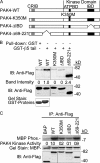p21-activated kinase 4 phosphorylation of integrin beta5 Ser-759 and Ser-762 regulates cell migration
- PMID: 20507994
- PMCID: PMC2911335
- DOI: 10.1074/jbc.M110.123497
p21-activated kinase 4 phosphorylation of integrin beta5 Ser-759 and Ser-762 regulates cell migration
Abstract
Modulation of integrin alphavbeta5 regulates vascular permeability, angiogenesis, and tumor dissemination. In addition, we previously found a role for p21-activated kinase 4 (PAK4) in selective regulation of integrin alphavbeta5-mediated cell motility (Zhang, H., Li, Z., Viklund, E. K., and Strömblad, S. (2002) J. Cell Biol. 158, 1287-1297). This report focuses on the molecular mechanisms of this regulation. We here identified a unique PAK4-binding membrane-proximal integrin beta5-SERS-motif involved in controlling cell attachment and migration. We also mapped the integrin beta5-binding site within PAK4. We found that PAK4 binding to integrin beta5 was not sufficient to promote cell migration, but that PAK4 kinase activity was required for PAK4 promotion of cell motility. Importantly, PAK4 specifically phosphorylated the integrin beta5 subunit at Ser-759 and Ser-762 within the beta5-SERS-motif. Point mutation of these two serine residues abolished the PAK4-induced cell migration, indicating a functional role for these phosphorylations in migration. Our results may give important leads to the functional regulation of integrin alphavbeta5, with implications for vascular permeability, angiogenesis, and cancer dissemination.
Figures









Similar articles
-
P21-activated kinase 4 interacts with integrin alpha v beta 5 and regulates alpha v beta 5-mediated cell migration.J Cell Biol. 2002 Sep 30;158(7):1287-97. doi: 10.1083/jcb.200207008. J Cell Biol. 2002. PMID: 12356872 Free PMC article.
-
Molecular basis for integrin adhesion receptor binding to p21-activated kinase 4 (PAK4).Commun Biol. 2022 Nov 17;5(1):1257. doi: 10.1038/s42003-022-04157-3. Commun Biol. 2022. PMID: 36385162 Free PMC article.
-
Integrin-mediated cell attachment induces a PAK4-dependent feedback loop regulating cell adhesion through modified integrin alpha v beta 5 clustering and turnover.Mol Biol Cell. 2010 Oct 1;21(19):3317-29. doi: 10.1091/mbc.E10-03-0245. Epub 2010 Aug 18. Mol Biol Cell. 2010. PMID: 20719960 Free PMC article.
-
Drug discovery targeting p21-activated kinase 4 (PAK4): a patent review.Expert Opin Ther Pat. 2021 Nov;31(11):977-987. doi: 10.1080/13543776.2021.1944100. Epub 2021 Aug 9. Expert Opin Ther Pat. 2021. PMID: 34369844 Review.
-
PAK4 signaling in health and disease: defining the PAK4-CREB axis.Exp Mol Med. 2019 Feb 12;51(2):1-9. doi: 10.1038/s12276-018-0204-0. Exp Mol Med. 2019. PMID: 30755582 Free PMC article. Review.
Cited by
-
Type II p21-activated kinases (PAKs) are regulated by an autoinhibitory pseudosubstrate.Proc Natl Acad Sci U S A. 2012 Oct 2;109(40):16107-12. doi: 10.1073/pnas.1214447109. Epub 2012 Sep 17. Proc Natl Acad Sci U S A. 2012. PMID: 22988085 Free PMC article.
-
PAK4 methylation by the methyltransferase SETD6 attenuates cell adhesion.Sci Rep. 2020 Oct 13;10(1):17068. doi: 10.1038/s41598-020-74081-1. Sci Rep. 2020. PMID: 33051544 Free PMC article.
-
Molecular determinants of αVβ5 localization in flat clathrin lattices - role of αVβ5 in cell adhesion and proliferation.J Cell Sci. 2022 Jun 1;135(11):jcs259465. doi: 10.1242/jcs.259465. Epub 2022 Jun 6. J Cell Sci. 2022. PMID: 35532004 Free PMC article.
-
p21-Activated Kinase 4 Promotes Intimal Hyperplasia and Vascular Smooth Muscle Cells Proliferation during Superficial Femoral Artery Restenosis after Angioplasty.Biomed Res Int. 2017;2017:5296516. doi: 10.1155/2017/5296516. Epub 2017 Jun 19. Biomed Res Int. 2017. PMID: 28706947 Free PMC article.
-
Normal mammary gland development after MMTV-Cre mediated conditional PAK4 gene depletion.Sci Rep. 2019 Oct 8;9(1):14436. doi: 10.1038/s41598-019-50819-4. Sci Rep. 2019. PMID: 31594963 Free PMC article.
References
Publication types
MeSH terms
Substances
LinkOut - more resources
Full Text Sources
Molecular Biology Databases
Research Materials
Miscellaneous

